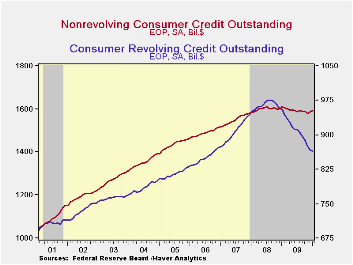 Global| Mar 08 2010
Global| Mar 08 2010U.S. Consumer Credit Records First Increase in Year
by:Tom Moeller
|in:Economy in Brief
Summary
Consumer credit outstanding during January posted its first gain in twelve months. Is a bottom to the year-long retrenchment in the making or will debt-laden balance sheets force further cutbacks? The $5.0B gain in credit reported by [...]
 Consumer
credit outstanding during January posted its first gain in twelve
months. Is a bottom to the year-long retrenchment in the making or will
debt-laden balance sheets force further cutbacks? The $5.0B gain in
credit reported by the Federal Reserve late-Friday was the first
monthly increase in a year and reversed December's $4.6B decline. This
two-month flattening of credit usage follows a record $23.9B November
shortfall. Also a record, year-to-year credit outstanding fell 4.2%.
During the last ten years, there has been a two-thirds correlation
between the y/y change in credit outstanding and the change in personal
consumption expenditures. The January increase contrasted with
Consensus expectations for a $4.5B drop.
Consumer
credit outstanding during January posted its first gain in twelve
months. Is a bottom to the year-long retrenchment in the making or will
debt-laden balance sheets force further cutbacks? The $5.0B gain in
credit reported by the Federal Reserve late-Friday was the first
monthly increase in a year and reversed December's $4.6B decline. This
two-month flattening of credit usage follows a record $23.9B November
shortfall. Also a record, year-to-year credit outstanding fell 4.2%.
During the last ten years, there has been a two-thirds correlation
between the y/y change in credit outstanding and the change in personal
consumption expenditures. The January increase contrasted with
Consensus expectations for a $4.5B drop.
Increased usage of
non-revolving credit (autos & other consumer durables), which
accounts for nearly two-thirds of the total, accounted for the January
increase.  The $6.6B rise followed a $4.9B December increase. Together
they recouped November's drop and since mid-2008 the trend in usage's
level has been sideways. Federal government & Sallie Mae
lending expanded by more than two-thirds y/y during January. That
increase offset an 11.5% decline in pools of securitized assets, a 0.3%
slip in commercial bank lending and a 1.2% fall in credit union
lending.
The $6.6B rise followed a $4.9B December increase. Together
they recouped November's drop and since mid-2008 the trend in usage's
level has been sideways. Federal government & Sallie Mae
lending expanded by more than two-thirds y/y during January. That
increase offset an 11.5% decline in pools of securitized assets, a 0.3%
slip in commercial bank lending and a 1.2% fall in credit union
lending.
Continued cutting of revolving credit usage in January held back the increase in overall credit usage. It fell $1.7B following much sharper declines through most of 2009. The latest was part of a record 9.6% y/y decline. Versus January 2009 finance companies lowered lending by one-quarter, commercial bank lending fell 10.8%, pools of securitized assets fell 8.8% while savings institutions pulled lending back 1.0% y/y. Loans from credit unions offset some of these declines with a 5.4% increase.
These figures are the major input to the Fed's quarterly Flow of Funds accounts for the household sector.
Credit data are available in Haver's USECON database. The Flow of Funds data are in Haver's FFUNDS database.
Stressed, Not Frozen: The Federal Funds Market in the Financial Crisis from the Federal Reserve Bank of New York can be found here here.
| Consumer Credit Outstanding (m/m Chg, SAAR) | January | December | November | Y/Y | 2009 | 2008 | 2007 |
|---|---|---|---|---|---|---|---|
| Total | $5.0B | $-4.6B | $-23.9B | -4.2% | -4.3% | 1.5% | 5.7% |
| Revolving | $-1.7B | $-9.4B | $-13.7B | -9.6% | -9.6% | 1.6% | 8.1% |
| Non-revolving | $6.6B | 4.9B | $-10.2B | -1.0% | -1.1% | 1.5% | 4.4% |
Tom Moeller
AuthorMore in Author Profile »Prior to joining Haver Analytics in 2000, Mr. Moeller worked as the Economist at Chancellor Capital Management from 1985 to 1999. There, he developed comprehensive economic forecasts and interpreted economic data for equity and fixed income portfolio managers. Also at Chancellor, Mr. Moeller worked as an equity analyst and was responsible for researching and rating companies in the economically sensitive automobile and housing industries for investment in Chancellor’s equity portfolio. Prior to joining Chancellor, Mr. Moeller was an Economist at Citibank from 1979 to 1984. He also analyzed pricing behavior in the metals industry for the Council on Wage and Price Stability in Washington, D.C. In 1999, Mr. Moeller received the award for most accurate forecast from the Forecasters' Club of New York. From 1990 to 1992 he was President of the New York Association for Business Economists. Mr. Moeller earned an M.B.A. in Finance from Fordham University, where he graduated in 1987. He holds a Bachelor of Arts in Economics from George Washington University.






